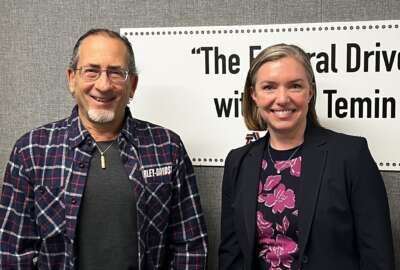Air Force learning to deal with smaller workforce
Doing more with less extends to human capital too. We learn how the Air Force is approaching the problem from Daniel Ginsberg.
wfedstaff | June 3, 2015 9:12 pm
By Olivia Branco
Federal News Radio
Defense Secretary Robert Gates has decided to cap the size of the civilian workforce. At the same time, the department is winnowing down its officer ranks as retention is at a 16 year high.
Live from Human Capital Management for Defense Conference, Daniel Ginsberg, Assistant Secretary of the Air Force for Manpower and Reserve Affairs, told our Tom Temin just how many service members the Air Force has.
“We have 37,000 airmen right now in support of contingencies,” Ginsberg said. “57,000 airmen abroad establishing presence showing the United States support for our allies and always serving as a constant warning to our enemies. And then we have literally over 140,000 airmen who are supporting needs across the globe every single day.”
The latest mandated cap on the workforce certainly effects the Air Force, the work they can do and the workers themselves.
Ginsberg said the Secretary capped the number of civilians the Air Force had at the end of fiscal year 2010. The cap at about 180,000 will alter the way work is done for them.
“We had some growth plans above that,” Ginsberg said about the cap. “So now we’re going to have to re-look at our growth plans and do almost a base line review to make sure we have our civilians exactly where we want them to basically get the most bang for our buck out of our people.
“We’re undertaking a very detailed review over the months ahead to make sure we have our people doing the right thing.”
One of the struggles with the cap is the 16 year high in terms of retention in the Air Force.
Ginsberg attributed that statistic to the current economy.
“People are staying so we are over our end strength,” Ginsberg said adding that “they are not necessarily in the areas where we have to have them.”
In order to lower the total number of people Ginsberg noted they are taking a series of measures to encourage some service members to leave.
“Some of it’s voluntary but some of it is involuntary,” Ginsberg said. “What’s key to the success of this is communication with our service members. Making sure that they know if they get involved with this process, we are there with them even if we ask them to leave.”
“We have a series of programs to help them transition into their new life, and we also have a very strong alumni association. We want them to know how successful our alumni are, not only in the federal government but also in the civilian sector and that there are many opportunities and that they’re still a part of the family.”
For more from this event, see Federal News Radio’s HCMD Conference page.
This story is part of Federal News Radio’s daily DoD Report. For more defense news, click here.
Copyright © 2025 Federal News Network. All rights reserved. This website is not intended for users located within the European Economic Area.





